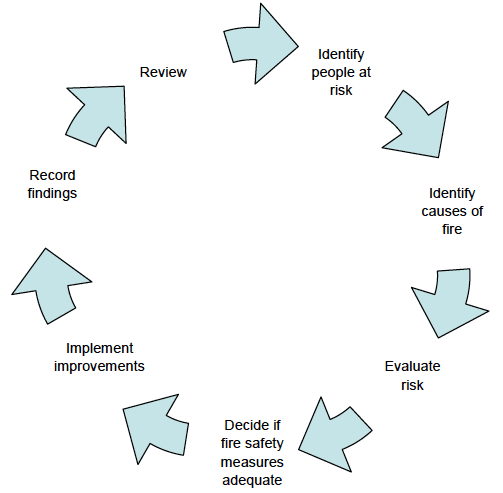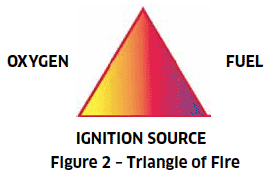Fire safety guidance for care homes
The guidance aims to assist those who have responsibility under the Fire (Scotland) Act 2005 for ensuring fire safety in care homes in Scotland.
CHAPTER 2: ASSESSMENT OF FIRE RISK IN PREMISES
37. In premises where fire safety law applies, it is a legal requirement to assess the premises to identify risk to persons from fire and to take fire safety measures. The assessment of risk should be specific to fire safety and to the specific care home concerned. A generic risk assessment will not be sufficient.
38. Fire safety risk assessment is a practical exercise aimed at evaluating the risk from fire and how to ensure the safety of persons in the event of fire. It involves an organised and methodical look at the home, the activities within the premises, the type of occupants, the potential for a fire to occur and the harm it could cause to people. The existing fire safety measures are evaluated to establish whether they are adequate or if more requires to be done. In this respect, fire safety measures include not just physical measures, such as fire alarm systems and escape routes, but also standards of management.
39. The risk assessment process described in this chapter is shown in Figure 1.
Figure 1 - Fire Safety Risk Assessment Process

Identify people at risk
40. An assessment should be made of those persons at risk if a fire occurs within or in the vicinity of the premises. The number, characteristics and location of occupants, residents, staff and other persons who frequent the premises should be identified. Disabilities should be taken into account along with people's familiarity with the premises. The inexperience, lack of awareness and immaturity of any young persons (under 18 years) employed or resident, should be also considered.
Identify causes of fire
41. For a fire to start, three components are needed: a source of ignition; fuel; and oxygen. These components can be represented as the sides in a simple 'Triangle of Fire' model shown in Figure 2. If any one of these components is missing, a fire cannot start. Taking steps to avoid the three coming together will reduce the chance of a fire occurring, while reducing the quantity of oxygen (smothering) or fuel (starvation) may restrict the development of a fire.

42. The premises should be critically examined to identify potential ignition sources and materials that might fuel a fire and the circumstances which might allow a fire to start, whether accidentally, deliberately or through lack of maintenance or precautions. Indications of 'near misses' should also be considered, such as scorch marks on furniture or fittings, discoloured or charred electrical plugs and sockets or cigarette burns. Some general information and examples are given in Table 1 at the end of this chapter and recommendations on controlling ignition sources are contained in Chapter 5.
Evaluate the risk
43. The risk in the premises should be evaluated so that a judgement can be made on the adequacy of fire safety measures. Risk has two components: the likelihood that a fire may occur; and the potential for a fire to cause death or injury, i.e. consequence. Both likelihood and consequence should be considered when assessing risk.
44. The likelihood of a fire starting will be low if there are few ignition sources, and if combustible materials are kept away from them.
45. Having considered the people likely to be at risk should a fire start in the building and the chances of a fire occurring, the consequences and extent of the risk to those people if a fire starts and spreads should be considered. In evaluating the risk to people, it is necessary to consider different situations and possible scenarios such as:
- Fire starting on a lower floor affecting the escape routes for people on upper floors;
- Fire developing in a space that people have to pass by to escape from the building;
- Fire or smoke spreading through a building via routes such as vertical shafts, service ducts, ventilation systems, walls, partitions, ceilings and roof voids; and
- Fire and smoke spreading through the building due to open doors, doors fitted with self-closers being wedged open or damaged doors.
Decide if existing fire safety measures are adequate
46. A judgement needs to be made to determine whether the fire safety measures and fire safety arrangements are adequate or if more needs to be done to safeguard persons.
47. The level of fire safety measures provided in the premises should be proportional to the level of risk posed to the safety of people.
Implement improvements
48. Carrying out an assessment of the premises is not an end in itself. The outcome of the risk assessment needs to be acted upon, risks need to be controlled in a practical way, and fire safety measures and arrangements need to be put in place.
49. Potential causes of fire identified should be avoided or removed if reasonably practicable to do so. If they cannot be removed, measures should be taken to control the risks.
50. Where improvements to fire safety measures in premises are considered necessary as a result of assessment of risk, a programme for implementation of the improvements should be drawn up. The programme should have timescales for the completion of the action required.
51. In implementing fire safety measures, fire safety law requires that certain principles be considered, these are:
- Avoiding risks;
- Evaluating risks which cannot be avoided;
- Combating risks at source;
- Adapting to technical progress (this may offer opportunities for improving fire safety);
- Replacing the dangerous with the non-dangerous or less dangerous;
- Developing a coherent fire prevention policy which covers technology, organisation of work and the influence of factors relating to the working environment;
- Giving collective fire safety protective measures priority over individual measures; and
- Giving appropriate instruction to employees.
52. Where improvements involve building work, the work should be done in accordance with Building Regulation procedures. In a listed building (a building of special architectural or historic interest included in a list compiled by the Scottish Ministers), alternatives to conventional fire safety measures may be appropriate. Guidance is available in Guide for Practitioners 7 Fire Safety Management in Traditional Buildings from Historic Scotland.
Record the findings
53. Having carried out a fire safety risk assessment of the premises, the findings should be recorded, including any action taken or action still to be taken. Fire safety law requires that certain information be recorded where five or more employees are employed (whether they are on the premises or not) or the premises is subject to licensing or registration or an Alterations Notice has been issued requiring this. Chapter 4 contains recommendations in respect of record keeping.
Review the assessment
54. The fire safety risk assessment should be reviewed before any changes are made, if relevant safety issues arise, and in any case regularly.
55. Where changes are proposed, the consequence to fire safety in the care home should be considered before the change is introduced. This will involve reviewing the risk assessment and considering whether the change would affect the risk and therefore whether the control measures are still appropriate. Changes that might prompt a review of the risk assessment include:
- A change in the number of people present or the characteristics or dependency of the occupants;
- Changes to work procedures, including the introduction of new equipment;
- Alterations to the building, including the internal layout;
- Significant changes to furniture and fixings; and
- The introduction or increase in the storage of dangerous substances.
56. A review should occur on becoming aware of shortcomings in fire safety measures, potential improvements; or a fire or 'near miss' occurs which may indicate that the existing fire safety measures are inadequate. If the Fire and Rescue Service has attended a fire in the premises, its fire investigation findings may help inform a review.
57. In any case, a review of the fire safety risk assessment should be carried out regularly. This will involve setting time aside to consider whether there has been any change which would affect the risk and therefore confirming that the control measures are still appropriate.
58. Generally, reviews of a risk assessment should be carried out in-house by the care home management and in so doing, this will reinforce ownership of fire safety management and assist in the development of relevant knowledge and of a fire safety culture.
IGNITION SOURCES
Potential ignition sources are those where sources of heat could get hot enough to ignite material found in the premises. These sources could include:
- Smokers' material - such as cigarettes, matches and lighters
- Naked flames - such as candles or gas open-flame equipment
- Heaters - electrical, gas or oil-fired (fixed or portable)
- Hot processes - such as repair work by contractors
- Cooking equipment and lighting equipment
- Deliberate fire-raising
- Electrical equipment or fixed installations.
There are various ways to reduce potential sources of ignition, for example:
- Replace naked flame and radiant heaters with a central heating system
- Restrict the movement of, and guard, portable heating appliances
- Install, use and maintain electrical and mechanical equipment in accordance with the manufacturer's instructions
- Take precautions to avoid deliberate fire-raising.
Fuel
Material which will burn and is in enough quantity may provide fuel for a fire. This includes contents, fixtures, fittings, structure, wall and ceiling linings and surfaces. Some examples of 'fuels' are:
- Textiles, soft furnishings, clothing and laundry
- Flammable liquids and solvents, such as white spirit, methylated spirit, cooking oils, disposable cigarette lighters and adhesives
- Wood, paper, cardboard, plastics, cellular foam, rubber and upholstered furniture
- Flammable gases such as liquefied petroleum gas (LPG) and aerosol contents.
There are various ways to reduce the materials and substances which burn, and to separate them from ignition sources, for example:
- Store flammable materials properly
- Remove combustible wall and ceiling linings, such as timber, polystyrene or carpet tiles (to reduce the surface rate of flame spread and smoke production)
- Ensure rubbish is not allowed to build up.
Oxygen
The main source of oxygen for a fire is in the air around us. Air supply can be by natural air flow through doors, windows and other openings; or mechanical air conditioning systems and air handling systems. Buildings may have a combination of sources capable of introducing or extracting air.
Potential sources of oxygen supplied to a fire can be reduced by:
- Closing doors and other openings
- Ensuring that doors are close fitting and, where appropriate, fitted with seals
- Closing down ventilation equipment.
The action may be a precaution taken in case a fire starts, such as keeping certain doors closed. In other cases, the action may take place once a fire is detected, such as when ventilation equipment is shut down (either manually or automatically), or when doors are closed, either manually or by the automatic release of hold-open devices.
Additional sources of oxygen can be from cylinder storage and piped systems used in oxygen therapy. High concentrations of oxygen pose a special hazard (see Chapter 5).
Contact
Email: Fire and Rescue Division
There is a problem
Thanks for your feedback